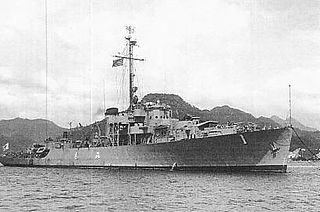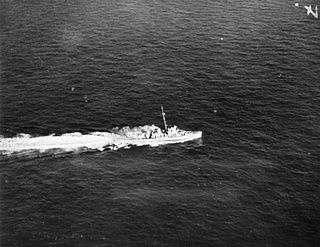
USS Threadfin (SS-410), a Balao-class submarine, was the only vessel of the United States Navy to be named for the threadfin.

USS Freedom (ID-3024) was a cargo and transport ship in the United States Navy during World War I. Originally SS Wittekind for the North German Lloyd line, the ship also served as USAT Iroquois and USAT Freedom after being seized by the United States in 1917.

USS Ranger, later USS Rockport and USS Nantucket (PG-23/IX-18), was a gunboat of the United States Navy. A screw steamer with full-rig auxiliary sail, Ranger was destined for a very long 65-year career, serving first as a U.S. Navy gunboat from 1876 to 1920, and later as a training ship with the Massachusetts Maritime Academy from 1909 to 1941.

USS Poughkeepsie (PF-26), a Tacoma-class frigate in commission from 1944 to 1945, was the first ship of the United States Navy to be named for Poughkeepsie, New York. She later served in the Soviet Navy as EK-27 and in the Japan Maritime Self-Defense Force as JDS Momi (PF-4), JDS Momi (PF-284), and as YAC-13.
USS Newport (PF-27), a Tacoma-class frigate in commission from 1944 to 1945, and from 1950 to 1952, was the second ship of the United States Navy to be named for the city of Newport, Rhode Island. She later served in the Soviet Navy as EK-28 and in the Japan Maritime Self-Defense Force as JDS Kaede (PF-13), JDS Kaede (PF-293) and as YAC-17.

USS Bangor (PF-16) was a United States Navy Tacoma-class frigate in commission from 1944 to 1946. Thus far, she has been the only U.S. Navy ship named for Bangor, Maine. She later served in United States Coast Guard as USCGC Bangor and in the Mexican Navy as ARM General José María Morelos and ARM Golfo de Tehuantepec.

The first USS Wilkes (TB-35) was a Blakely-class torpedo boat in the United States Navy.

USS McClelland (DE-750) was a Cannon-class destroyer escort built for the United States Navy during World War II. She served in the Pacific Ocean and provided escort service against submarine and air attack for Navy vessels and convoys. Post-war she was reassigned as a training vessel.

USS Rizzi (DE-537) was a John C. Butler-class destroyer escort in service with the United States Navy from 1945 to 1946 and from 1951 to 1958. She was sold for scrapping in 1974.

USS Benewah (APB-35) was a barracks ship of the United States Navy, and lead ship of her class. She was notable for her service in World War II, Korean War, and Vietnam War.

USS Maple, was a lighthouse tender that served in the United States Navy from 1893 to 1899, seeing service as an auxiliary ship during the Spanish–American War in 1898, and from 1917 to 1919, operating as a patrol vessel during World War I. She also served as USLHT Maple in the United States Lighthouse Board fleet from 1899 to 1910 and in the United States Lighthouse Service from 1910 to 1933.

USS Burlington (PF-51) was a Tacoma-class frigate in commission from 1944 to 1945 and from 1951 to 1952, the only United States Navy ship thus far to have been named for Burlington, Iowa. She also served in the Soviet Navy as EK-21 and in the Colombian National Armada as ARC Almirante Brión.
The second USS Bath (PF-55) was a United States Navy Tacoma-class frigate in commission from 1944 to 1945 which later served in the Soviet Navy as EK-29 and the Japanese Maritime Self-Defense Force, with her Japanese name reported by various sources as JDS Maki (PF-18) and JDS Maki (PF-298), and later as YTE-9.
The first USS Apache, later USS Aspinet (YF-176), was a United States Navy tug in commission during 1898, which then served again as a freight lighter from 1900 to 1925.
HMS Flax, a modified Flower-class corvette, was laid down on 28 February 1942 at Kingston, Ontario, Canada, by War Supplies Ltd., for the Royal Navy. Launched on 15 June 1942 it was reallocated to the United States under the so-called "Reverse Lend-Lease" program and renamed and redesignated Brisk (PG-89) on 14 August 1942. Completed on 5 December 1942, the ship was commissioned on 6 December 1942.

The first USS Algorma (AT-34) was laid down on 6 January 1919 at Port Richmond, NY, by the Staten Island Shipbuilding Co.; launched on 12 June 1919; and commissioned on 15 May 1920 at the New York Navy Yard, Brooklyn, NY.

USS Avoyel (ATF-150) was an Navajo-class fleet tug built for the United States Navy during World War II. She was the only U.S. Naval vessel to bear the name.

The second HMS Moorsom (K567) was a British Captain-class frigate of the Royal Navy in commission during World War II. Originally constructed as the United States Navy Evarts-class destroyer escort DE-522, she served in the Royal Navy from 1943 to 1945.

Augustus Francis Fechteler was a Rear Admiral of the United States Navy during World War I. He had two sons also served in the Navy, Admiral William Fechteler was Chief of Naval Operations and Lieutenant Frank Caspar Fechteler, an early naval aviator that died in an airplane crash 18 September 1922.














